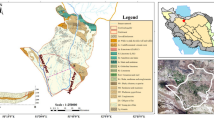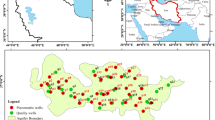Abstract
This paper presents a new methodology for analyzing the spatiotemporal variability of water table levels and redesigning a groundwater level monitoring network (GLMN) using the Bayesian Maximum Entropy (BME) technique and a multi-criteria decision-making approach based on ordered weighted averaging (OWA). The spatial sampling is determined using a hexagonal gridding pattern and a new method, which is proposed to assign a removal priority number to each pre-existing station. To design temporal sampling, a new approach is also applied to consider uncertainty caused by lack of information. In this approach, different time lag values are tested by regarding another source of information, which is simulation result of a numerical groundwater flow model. Furthermore, to incorporate the existing uncertainties in available monitoring data, the flexibility of the BME interpolation technique is taken into account in applying soft data and improving the accuracy of the calculations. To examine the methodology, it is applied to the Dehgolan plain in northwestern Iran. Based on the results, a configuration of 33 monitoring stations for a regular hexagonal grid of side length 3600 m is proposed, in which the time lag between samples is equal to 5 weeks. Since the variance estimation errors of the BME method are almost identical for redesigned and existing networks, the redesigned monitoring network is more cost-effective and efficient than the existing monitoring network with 52 stations and monthly sampling frequency.




















Similar content being viewed by others
References
Alizadeh, Z., and Mahjouri, N. (2017). A spatiotemporal Bayesian maximum entropy-based methodology for dealing with sparse data in revising groundwater quality monitoring networks: the Tehran region experience. Environmental Earth Sciences 76:436.
Barca, E., Calzolari, M. C., Passarella, G., & Ungaro, F. (2013). Predicting shallow water table depth at regional scale: optimizing monitoring network in space and time. Water Resources Management, 27(15), 5171–5190.
Barca, E., Passarella, G., Vurro, M., & Morea, A. (2015). MSANOS: data-driven, multi-approach software for optimal redesign of environmental monitoring networks. Water Resources Management, 29(2), 619–644.
Bhat, S., Motz, L. H., & Pathak, C. (2015). Geostatistics-based groundwater-level monitoring network design and its application to the Upper Floridan aquifer, USA. Environmental Monitoring and Assessment, 187, 4183. doi:10.1007/s10661-014-4183-x.
Chikodzi, D., & Mutowo, G. (2016). Using river altitude determined from a SRTM DEM to estimate groundwater levels of the Tokwe and Mutirikwi watersheds in Zimbabwe. Journal of Geographic Information System, 8(1), 65–72. doi:10.4236/jgis.2016.81007.
Christakos, G. (1990). A Bayesian/maximum-entropy view to the spatial estimation problem. Mathematical Geology, 22(7), 763–777.
Christakos, G. (1991). Some applications of the BME concepts in geostatistics. In W. T. Grandy & L. H. Schick (Eds.), Maximum entropy and Bayesian methods (pp. 215–229). Dordrecht: Kluwer Acad. Publ.
Christakos, G. (1998). Spatiotemporal information systems in soil and environmental sciences. Geoderma, 85(2–3), 141–179.
Christakos, G., & Li, X. (1998). Bayesian maximum entropy analysis and mapping: a farewell to kriging estimators. Mathematical Geology, 30(4), 435–462.
Christakos, G., Serre, M. L., & Kovitz, J. (2001). BME representation of particulate matter distributions in the state of California on the basis of uncertain measurements. Journal of Geophysical Research., 106(D9), 9717–9731.
Christakos, G., Bogaert, P., & Serre, M. L. (2002). Temporal GIS. New York: Springer-Verlag Press.
Cressie, N., & Huang, H. C. (1999). Classes of nonseparable, spatio-temporal stationary covariance functions. Journal of the American Statistical Association, 94, 1330–1340.
Davis, J. C., & Olea, R. A. (1998). Hexagonal basis of the observation well network. In: R. D. Miller, J. C. Davis, and R. A. Olea (Eds.), 1998 Annual water level raw data report for Kansas. Open-File Report No. 98–7 (electronic version): Kansas Geological Survey.
De Cesare, L., Myers, D., Posa, D. (1997). Spatial-temporal modeling of SO2 in milan district. In: E. Y. Baafi, N. A. Schofield (eds) Geostatistics Wollongong Vol. 96(2), (pp. 1031–1042). Dordrecht: Kluwer Academic.
De Cesare, L., Myers, D., & Posa, D. (2001). Product-sum covariance for space-time modeling. Environmetrics, 12, 11–23.
Delbari, M., Motlagh, M. B., & Amiri, M. (2013). Spatio-temporal variability of groundwater depth in the Eghlid aquifer in southern Iran. Earth Sciences Research Journal, 17(2), 105–114.
Fasbender, D., Peeters, L., Bogaert, P., and Dassargues, A. (2008). Bayesian data fusion applied to water table spatial mapping. Water Resources Research, 44(12). doi:10.1029/2008WR006921.
Finkenstadt, B., Held, L., & Isham, V. (2006). Statistical methods for spatio-temporal systems. USA: CRC Press, Chapmann and hall.
Fullér, R., & Majlender, P. (2003). On obtaining minimal variability OWA operator weights. Fuzzy Sets and Systems, 136, 203–215.
Goovaerts, P. (1997). Geostatistics for natural resources evaluation. New York: Oxford University Press.
Hosseini, M., and Kerachian, R. (2017). A data fusion-based methodology for optimal redesign of groundwater monitoring networks. Journal of Hydrology 552:267–282.
Isaaks, E., & Srivastava, R. M. (1989). An introduction to applied geostatistics. New York: Oxford University Press.
Kitanidis, P. K. (1997). Introduction to geostatistics: application to hydrogeology. Cambridge: Cambridge University Press.
Krige, D. G. (1951). A statistical approach to some basic mine valuation problems on the Witwatersrand. Journal of the Chemical, Metallurgical and Mining Society of South Africa, 52(6), 119–139.
Kumar, S., Sondhi, S. K., & Phogat, V. (2005). Network design for groundwater level monitoring in upper Bari Doab canal tract, Punjab, India. Irrigation and Drainage, 54(4), 431–442.
Mahab Ghods Consulting Engineering Company (2014). Integrated studies and mathematical groundwater modeling of the Ghorveh and Dehgolan plains. Technical Report (in Persian).
Manzione, R. L., Wendland, E., & Tanikawa, D. H. (2012). Stochastic simulation of time-series models combined with geostatistics to predict water-table scenarios in a Guarani Aquifer System outcrop area, Brazil. Hydrogeology Journal, 20(7), 1239–1249.
Nourani, V., Ejlali, R. G., & Alami, M. T. (2011). Spatiotemporal groundwater level forecasting in coastal aquifers by hybrid neural networks-geostatistics model: a case study. Environmental Engineering Science, 28(3), 217–228. doi:10.1089/ees.2010.0174.
O’Hagan, M. (1990). Using maximum entropy-ordered weighted averaging to construct a fuzzy neuron (pp. 618–623). Proc., 24th Annual IEEE Asilomar Conf. on Signals, Systems and Computers, Pacific Grove, Calif.
Olea, R. A. (1984). Sampling design optimization for spatial functions. Mathematical Geology, 16(4), 369–392.
Peeters, L., Fasbender, D., Batelaan, O., and Dassargues, A. (2010). Bayesian data fusion for water table interpolation: incorporating a hydrogeological conceptual model in kriging. Water Resources Research, 46(8). doi:10.1029/2009WR008353.
Ran, Y., Li, X., Lu, X., & Lian, Y. (2015). Optimal selection of groundwater-level monitoring sites in the Zhangye Basin, Northwest China. Journal of Hydrology, 525, 209–215.
Serre, M. L., & Christakos, G. (1999). Modern geostatistics: Computational BME analysis in the light of uncertain physical knowledge—the Equus Beds study. Stochastic Environmental Research and Risk Assessment, 13(1), 1–26.
Sophocleous, M., Paschetto, J. E., & Olea, R. A. (1982). Groundwater network design for Northwest Kansas, using the theory of regionalized variables. Ground Water, 20(1), 48–58.
Triki, I., Zairi, M., & Dhia, H. B. (2013). A geostatistical approach for groundwater head monitoring network optimization: case of the Sfax superficial aquifer (Tunisia). Water and Environment Journal, 27(3), 362–372.
Varouchakis, E. A., & Hristopulos, D. T. (2013). Comparison of stochastic and deterministic methods for mapping groundwater level spatial variability in sparsely monitored basins. Environmental Monitoring and Assessment, 185(1), 1–19.
Yager, R. R. (1988). On ordered weighted averaging aggregation operators in multi-criteria decision making. IEEE Transactions on Systems, Man, and Cybernetics, 18(1), 183–190.
Yu, H. L., & Chu, H. J. (2009). Understanding space-time patterns of groundwater system by empirical orthogonal functions: a case study in the Choshui River alluvial fan, Taiwan. Journal of Hydrology, 381(3–4), 239–247. doi:10.1016/j.jhydrol.2009.11.046.
Yu, H. L., & Lin, Y. C. (2012). Recharge signal identification based on groundwater level observations. Environmental Monitoring and Assessment, 184(10), 5971–5982.
Yu, H. L., & Lin, Y. C. (2015). Analysis of space–time non-stationary patterns of rainfall–groundwater interactions by integrating empirical orthogonal function and cross wavelet transform methods. Journal of Hydrology, 525, 585–597.
Zhou, Y., Dong, D., Liu, J., & Li, W. (2013). Upgrading a regional groundwater level monitoring network for Beijing Plain, China. Geoscience Frontiers, 4(1), 127–138.
Acknowledgments
This research has been financially supported by Iran National Science Foundation (INSF) under grant number no. 95849284. The authors would like to thank Dr. Mark Serre from the University of North Carolina for his invaluable clarification of some aspects related to the BME. Also, we would like to acknowledge the Mahab Ghods Consulting Engineering Company for sharing the MODFLOW-based groundwater flow simulation model of the Dehgolan plain.
Author information
Authors and Affiliations
Corresponding author
Rights and permissions
About this article
Cite this article
Hosseini, M., Kerachian, R. A Bayesian maximum entropy-based methodology for optimal spatiotemporal design of groundwater monitoring networks. Environ Monit Assess 189, 433 (2017). https://doi.org/10.1007/s10661-017-6129-6
Received:
Accepted:
Published:
DOI: https://doi.org/10.1007/s10661-017-6129-6




